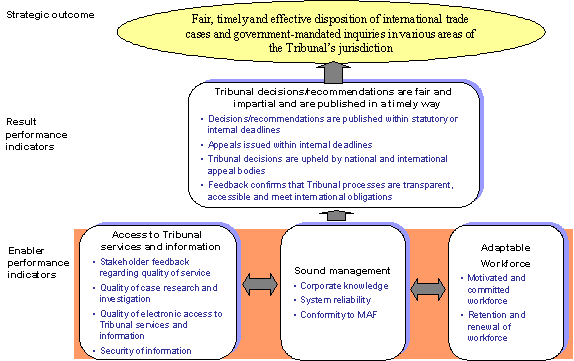Common menu bar links
Breadcrumb Trail
ARCHIVED - RPP 2007-2008
Canadian International Trade Tribunal
 This page has been archived.
This page has been archived.
Archived Content
Information identified as archived on the Web is for reference, research or recordkeeping purposes. It has not been altered or updated after the date of archiving. Web pages that are archived on the Web are not subject to the Government of Canada Web Standards. As per the Communications Policy of the Government of Canada, you can request alternate formats on the "Contact Us" page.
SECTION II—ANALYSIS OF PROGRAM ACTIVITIES BY STRATEGIC OUTCOME
Overall Logic Model and Performance Indicators
The Tribunal has a single strategic outcome:
Fair, timely and effective disposition of international trade cases and government-mandated inquiries in various areas of the Tribunal’s jurisdiction.
The result to be achieved in support of this strategic outcome is that the Tribunal’s processes, decisions and recommendations are fair, transparent and impartial (and are viewed so by stakeholders) and are made available to interested parties and to the public, in both official languages, to meet legislative deadlines through the most efficient means at our disposal. The Tribunal has two activities that contribute to the above result: the adjudication of trade cases (quasi-judicial role) and general economic inquiries and references (advisory role). The relationship between the activities, result and strategic outcome, as well as the performance indicators associated with this result, is summarized in the chart below.
Summary Logic Model of the Tribunal

Described below, for both program activities, are the performance objectives that the Tribunal is striving to achieve and the manner in which the Tribunal’s plans and priorities discussed earlier support these performance objectives. The performance objectives vary somewhat in application depending on the nature of the activity, i.e. the adjudication of trade cases or general economic inquiries and references.
Activity #1—Adjudication of Trade Cases (quasi-judicial role)
The adjudication of trade cases is a quasi-judicial activity that includes unfair trade cases, appeals from decisions of the CBSA and the CRA, safeguard inquiries, and bid challenges relating to federal government procurement.
Financial Resources: ($ thousands)
|
2007-2008 |
2008-2009 |
2009-2010 |
|
10,058 |
9,438 |
9,438 |
Human Resources: (FTE)
|
2007-2008 |
2008-2009 |
2009-2010 |
|
88 |
88 |
88 |
Result: Tribunal decisions are fair and impartial and published in a timely way.
This result is the ongoing primary concern of the Tribunal. Key performance objectives include:
• Decisions/determinations are published within statutory deadlines. The Tribunal’s decisions regarding dumping and/or subsidizing, safeguard inquiries and procurement complaints are subject to statutory deadlines. The Tribunal’s first priority is therefore to ensure that these decisions are fair and impartial and issued within these deadlines. The Tribunal has implemented strong case management controls to ensure that it is able to meet these deadlines and does extensive tracking of the status of cases to ensure close adherence to prescribed deadlines. Detailed reports exist on the status of cases.
• Appeals issued within internal deadlines. There is no statutory deadline imposed for the decisions on appeals of the CBSA and the CRA decisions. However, the Tribunal has adopted an informal, voluntary standard of publishing such decisions within 120 days of the hearing of an appeal. Tribunal management closely monitors these files to ensure that, to the greatest extent possible, the Tribunal adheres to this standard.
• Tribunal decisions are upheld by national and international appeal bodies. An indicator of the soundness of Tribunal decisions is the number of decisions that are upheld. The Tribunal’s decisions on dumping and subsidizing matters may be reviewed by the Federal Court of Appeal or a bi-national panel under NAFTA in the case of a decision affecting U.S. and/or Mexican goods. WTO member states whose goods are affected by a Tribunal decision may also initiate dispute settlement proceedings under the WTO Understanding on Rules and Procedures Governing the Settlement of Disputes, if they believe that the Tribunal’s procedures violated the WTO Agreement on Implementation of Article VI of the General Agreement on Tariffs and Trade 1994. The Tribunal’s decisions on appeals may be appealed to the Federal Court of Appeal or, in the case of the Excise Tax Act, the Federal Court. The Tribunal monitors whether its decisions have been the subject of applications for judicial review or appeals before these bodies. It determines, based on the issues raised in these applications, whether it will seek intervener status before the Federal Court of Appeal. It is automatically a party in any bi-national panel review under NAFTA.
• Feedback on whether the Tribunal’s processes are transparent, accessible and meet international obligations. The WTO publishes comments every two years, through its Trade Policy Review Mechanism, on whether Canada and the Tribunal have fostered a fair and open trading system that is transparent and accessible and meets international obligations.
Activity #2—General Economic Inquiries and References (advisory role)
General economic inquiries and references are advisory activities of the Tribunal. These include general economic inquiries referred by the government and tariff references referred by the Minister of Finance.
Financial Resources: ($ thousands)
|
2007-2008 |
2008-2009 |
2009-2010 |
|
624 |
624 |
624 |
Human Resources: (FTE)
|
2007-2008 |
2008-2009 |
2009-2010 |
|
6 |
6 |
6 |
Result: Recommendations are fair and impartial and published in a timely way.
Key performance objectives are similar to those outlined above and include:
• Reports, determinations and recommendations are published within government-mandated deadlines. The Tribunal’s decisions regarding tariff references and economic inquiries are subject to government-mandated deadlines. The Tribunal has implemented strong case management controls to ensure that it is able to meet these deadlines and does extensive tracking of the status of cases.
• Tribunal determinations are upheld by national and international appeal bodies. An indicator of the soundness of Tribunal determinations is the number of determinations that were appealed and upheld, i.e. whether applications are dismissed or discontinued by appeal bodies.
